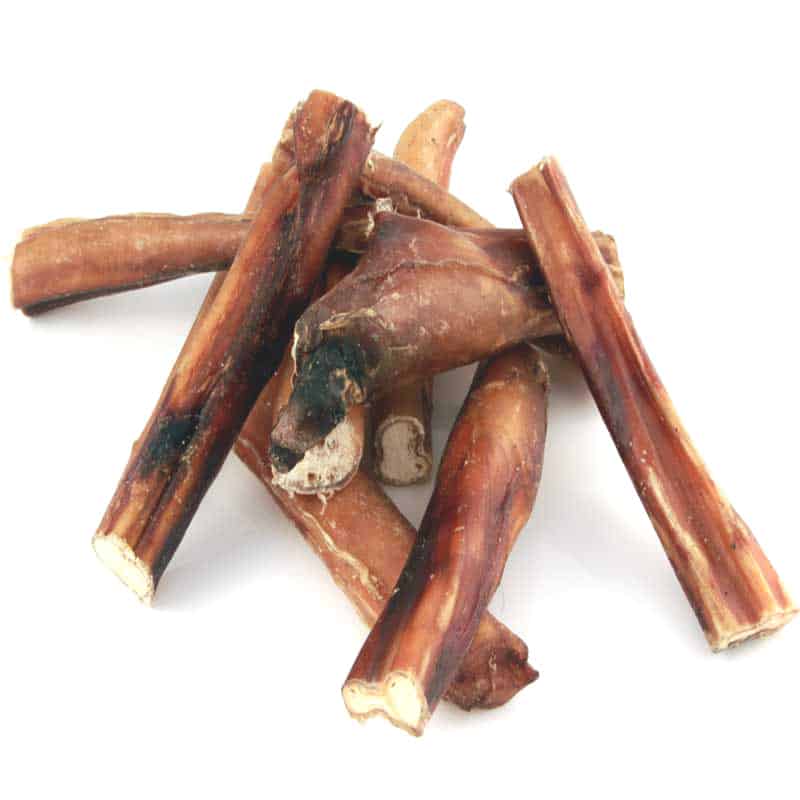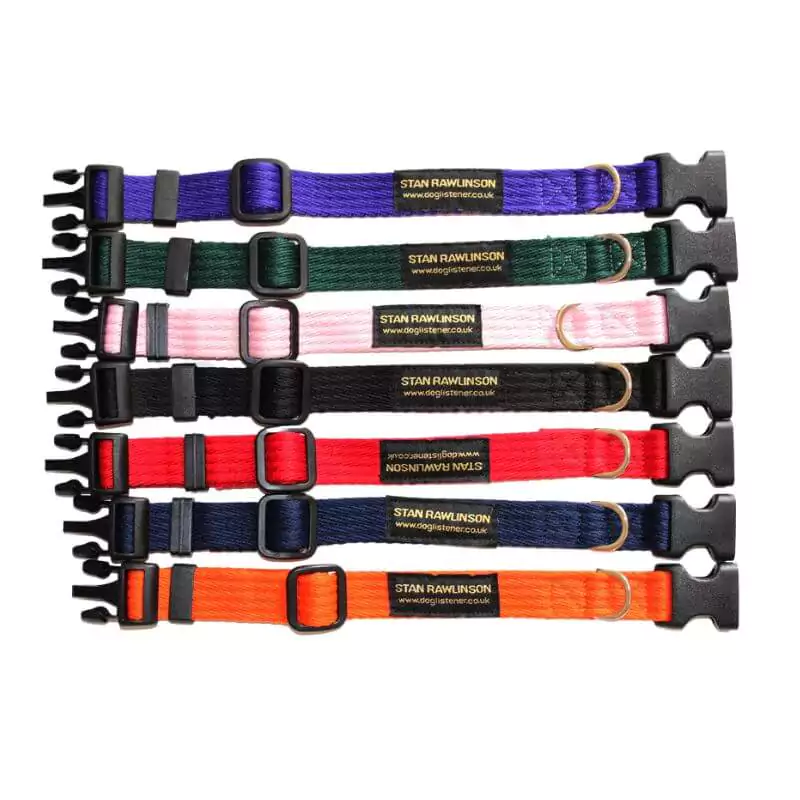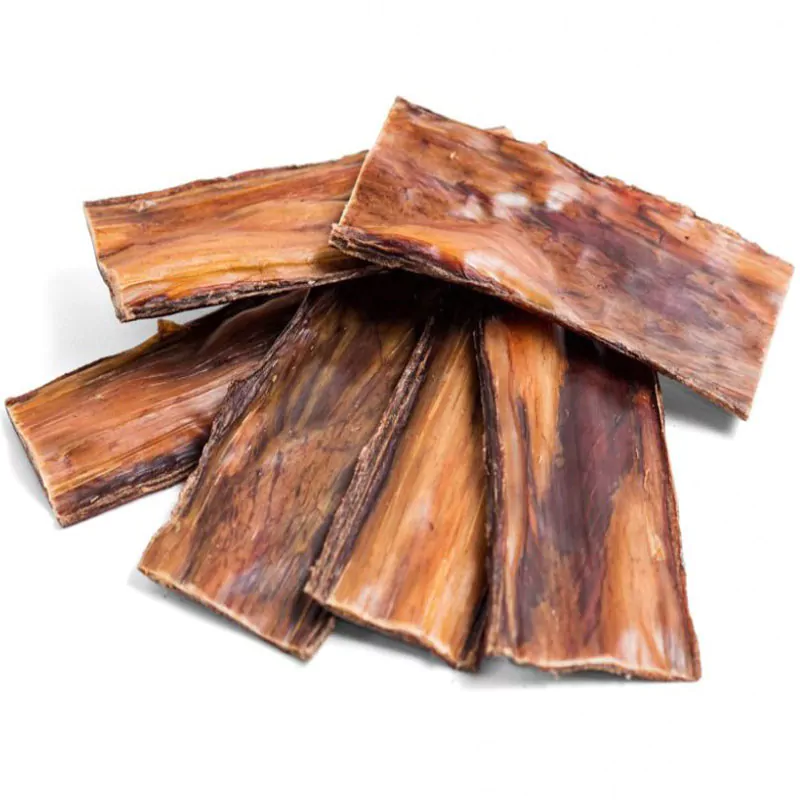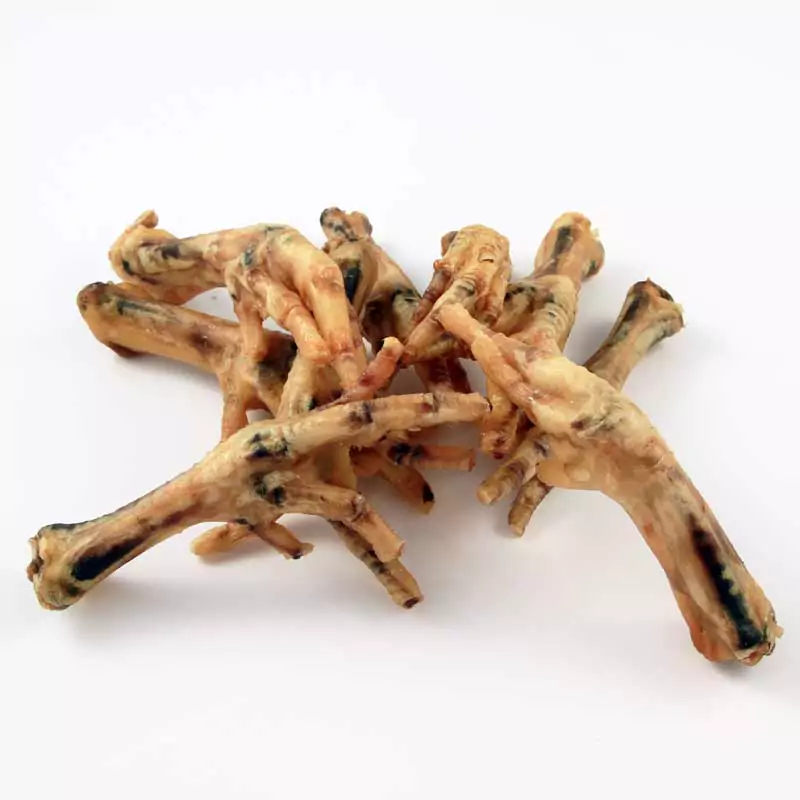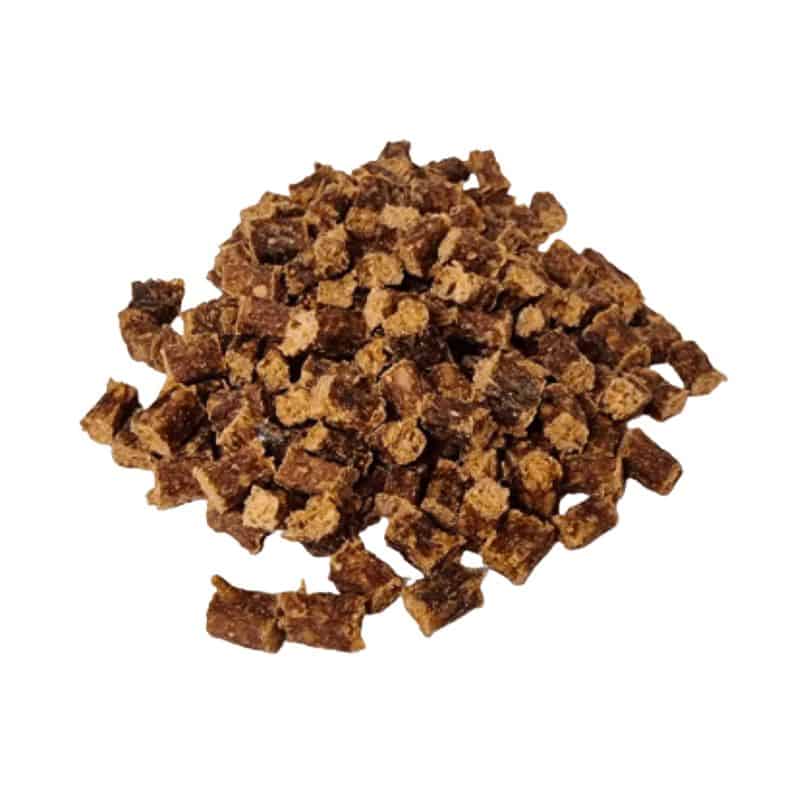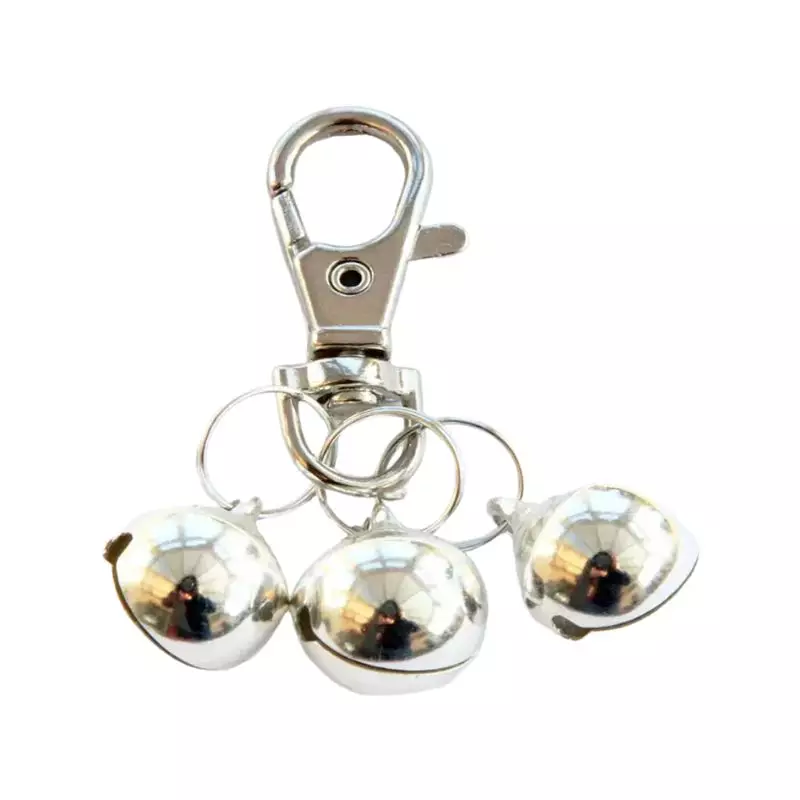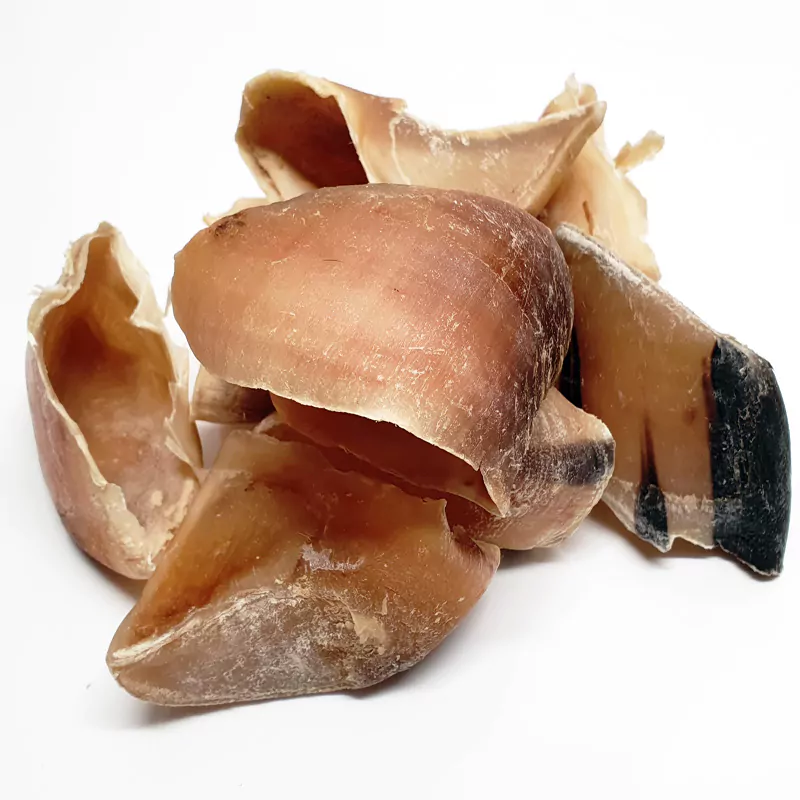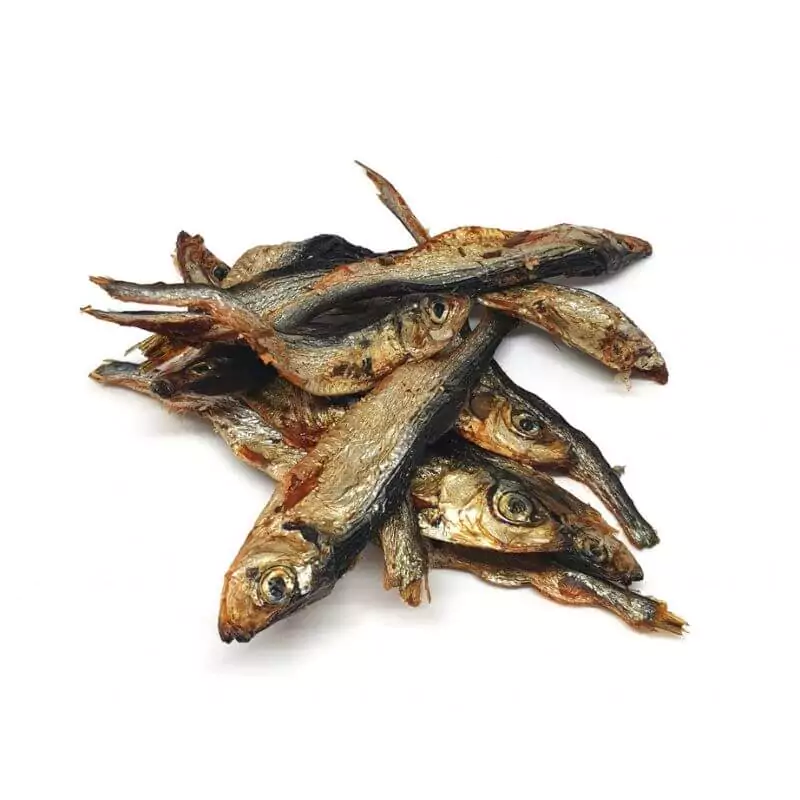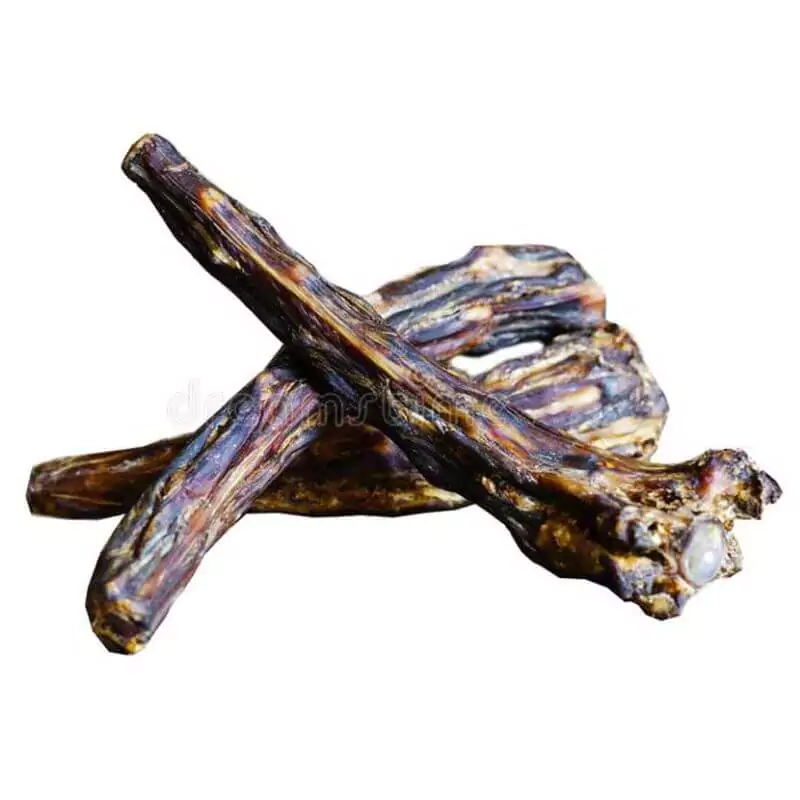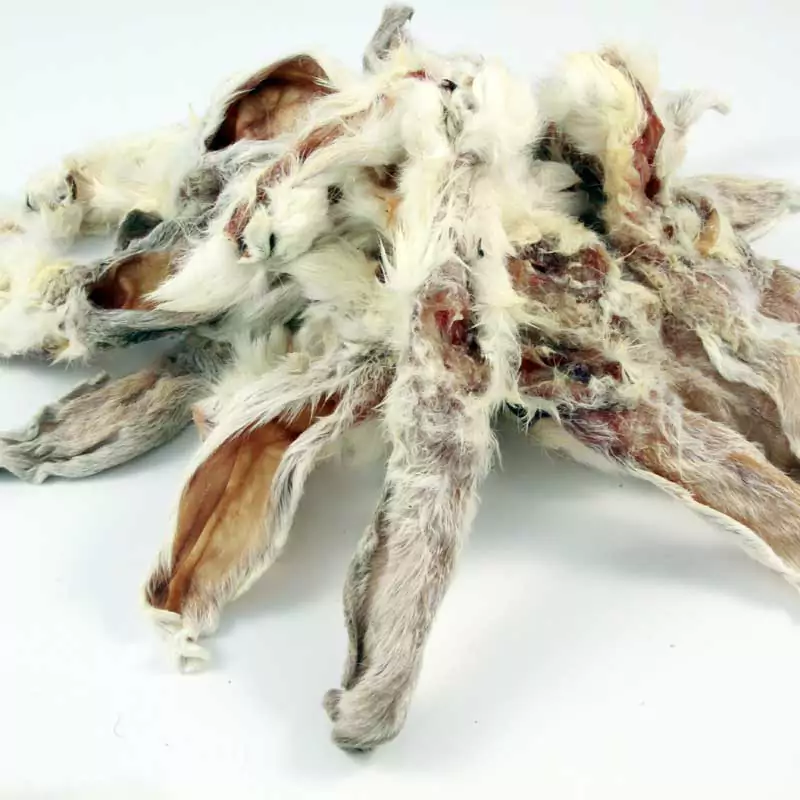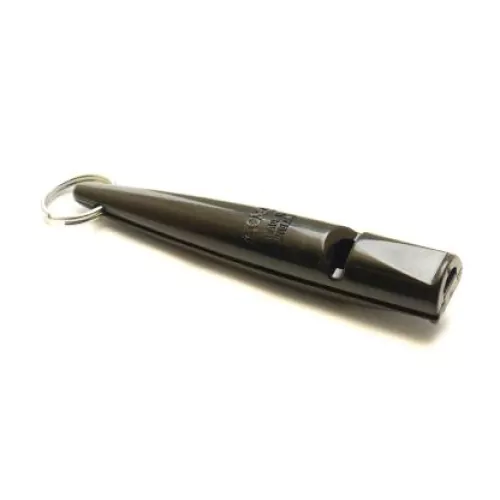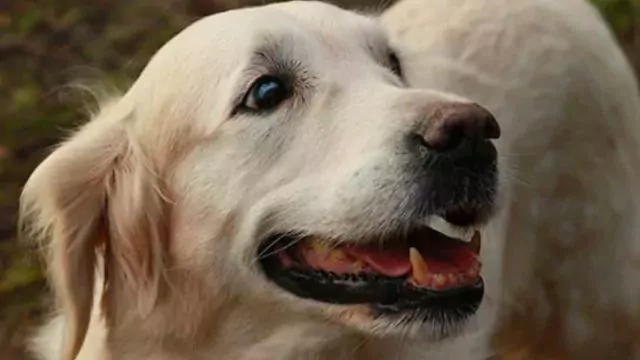Fearful Anxious and Timid Dogs
The Fearful Anxious Nervous and Timid Dog
Understanding the fearful, nervous, anxious, timid and scared dog. including aggression related to fear and anxiety
Fearful and anxious dogs are one of the commonest behavioural problems in domestic dogs. Some cases are genetic, however, most are created by the very people who really wanted the best for their dogs. It is often the breeders and the first owners that create this debilitating problem. This article will hopefully give you an insight into your own dog’s behaviour, and what you can do to help your dogs. and to understand what may have gone wrong so you can make sure you do not make the same mistakes again.
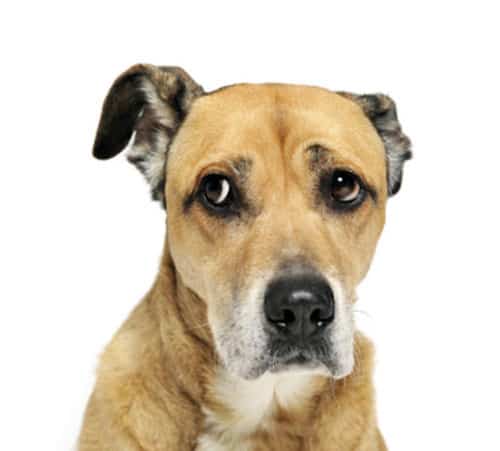
Socialisation is Vital: Socialisation is so vitally important that it almost outweighs all other considerations.
Lack of early socialisation is the most important and the commonest contributing factor in creating fearful, anxious and timid dogs
The fear of infections has led breeders and owners alike to make the tragic mistake of keeping their puppies isolated until they have completed their vaccinations.
Your dogs can mix with people and other vaccinated dogs from the day they are born.
The two most important time frames are 0-12 weeks Human Socialisation Period and 0-16 weeks Canine Socialisation Period.
Your puppy should have been handled by a minimum of 100 people by the time it is 12 weeks old. This should include children, adults and pensioners.
Over 90% of all cases of aggression against humans or other dogs are fear-based, yet we are constantly told that these aggressions are dominance-based That could not be further from the truth.
The breeder should play a vital part in this by inviting people to handle their puppies at a very young age. The canine socialisation period up to 16 weeks means they should be mixed with other dogs but more importantly other puppies. Pups learn communication skills, bite inhibition and body language from the boisterous play with other young puppies. Older dogs do not play as puppies do, therefore puppy classes that allow the pups to play together are absolutely crucial to your pups future confidence and mental health,
In my local area, there are lots of trainers and behaviourists that hold puppy classes. Quite a few do not have a clue about how puppies learn and do not even allow the puppies to play off the lead. If you are in one of these classes just walk out and demand your money back, if they do not allow this interaction between the other puppies. Why do they imagine they called Puppy Socialisation Classes.
By taking this stance they risk their clients ending up with a fearful, timid dog that may become aggressive in later life, (FACT “95% of all reported dog bites are fear related” Owners should try and strike a common-sense balance.
The First Weeks are Critical: Puppies, especially from birth through to 16 weeks must be exposed to a variety of experiences including people, places, and meeting other vaccinated dogs (this is perfectly safe). There are many activities and places to take dogs, without endangering their health or their lives, it is vital that you take the time to expose your new pup to as many of these situations as possible.
This is especially true for one’s second or third dog; it is too easy to keep the new pup in the company of the older dogs, depriving him of the opportunity to develop self-confidence of his own, without relying totally on the older dog/s and their protection. There is a vaccination that has been available for years, where the full course can be administered by ten and a half weeks rather than the normal twelve, therefore allowing two extra vital weeks of socialisation.
The vaccine is made by Intervet and is called Nobivac D.H.P.P.I/L. I would discuss this with your Vet if they don’t supply it ask why?
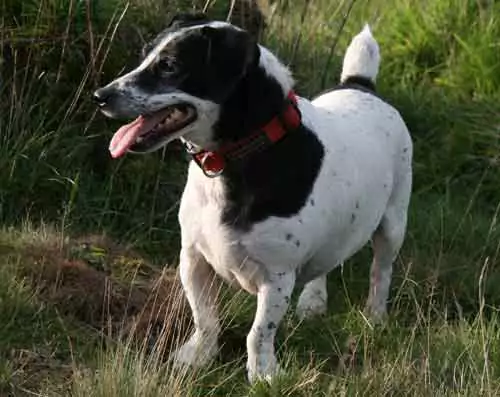
Genetics: Genetics, as well as socialisation. ie Nature and Nurture has a major impact on your dog’s ability to cope successfully with life.
Some are so solid genetically that whatever life throws at them they just bounce back.
I had a little rescue Jack Russell/Dachshund cross (A stretch limo Jack) called Charlie.
His early experiences were so horrific, that he should have had every hang up in the book.
See picture left. The abuse and injuries suffered by this poor little dog include both his back legs being fractured and snapped out of their socket, Front shoulder plate broken.
He has plates and pins all over him. Each one of his ribs was systematically broken at least three times over a period of 5 months.
This abuse started when he was 8 weeks old. He also has many other injuries,.including a fractured skull, collapsed eye socket and teeth missing. At one point he had black eyes and blood coming out of almost every orifice. His head was swollen to almost twice the normal size. The picture of him shows him smiling and happy.
He was so traumatised he would defecate, urinate and vomit if people approached him. His brother did not make it. he sadly died of head injuries at the hands of the sadist who then turned his full attention onto Charlie. This dog had been treated and put back together on numerous occasions, and each time the family had claimed it was an accident.
It was fairly clear this was not the case, especially after taking an X-ray of his ribs. Yet it appears the Vet was prepared to put this poor little dog back together and hand him back for more torture. I was asked to look at his temperament after a brilliant senior veterinary nurse called Helen, managed to convince the owners to give the dog up, with a view to re-homing. She looked after him personally and nursed him back to health.
There were no prosecutions!. After meeting him and hearing his awful story I was asked if I could work with him to try and overcome his massive fear of people. It took me almost three months to really get him to start to trust people and he stayed with me for the rest of his life Unfortunately I had difficulty going on holiday as he would just stop eating. He made a total and full recovery, his confidence soared, once again he loved and trusted people, his tail a constant blur was a testament to his ability to cope with everything life has thrown at him.
So despite a traumatic start, (the abuse started at eight weeks of age) he managed to overcome this and became one of the nicest and most loving dogs I have ever owned. He even became a PAT dog and was the only dog that was allowed into “Shooting “Star” The children’s Hospice in Greater London. Postscript Charlie died of heart failure aged 13 years in 2014, he is still sorely missed, not just by me and my family but everyone that ever met him, especially this that knew his story.
Many thanks go to Helen who impressed me so much that I decided to help her in her quest for more knowledge and understanding of the behaviour of dogs. She shadowed me in my work. Helen is now a behaviourist and trainer in her own right.
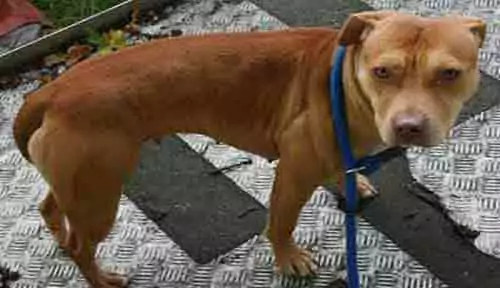
Unfortunately, not all dogs are so genetically sound. Even with an ideal environment, early socialisation and the perfect owner.
This may not be enough to help these hereditary unstable dogs. Their genetic temperament can and will determine how much improvement in personality and social skills the dog can achieve.
It is about time that some breeders came to the realisation that temperament, not looks or conformity, should be the main reason for breeding. Not money or accolades!
I have written an article about the impact (1) Breeders have on our dogs. The dog pictured above is a young Staffie I assessed under the Dangerous Dogs Act 1991.
Her owner was apprehended by the police in the street. They wrestled the man to the ground and arrested him. She panicked so much she barked and threatened the police and then went to nip them.
She was six months old when taken into custody and put in solitary confinement for her actions for months on end. I assessed this poor dog for temperament and aggression. Because of that report and my appearance in court to defend her meant that she was fortunately returned to her owner.
However, her life and fears will probably be with her until she dies. Just sometimes our police and the law should take into consideration the age and circumstances of the dog when deciding to prosecute in cases like these..
Is There a Cure?: With fear behaviour, don’t expect a 100% cure. There is no miracle word or magic wand that miraculously changes the dog, do not underestimate the amount of work involved. Yes, you can create a less fearful and anxiety-ridden dog, but only to the level that the dog can sustain.
The type of owner or trainer that believes that the fearful dog should be thrust headlong into every situation, and that will desensitise and cure them is sadly disillusioned. The old trick of throwing a child into a swimming pool in the hope it would quickly learn to swim is now hopefully outdated.
It achieved nothing except possibly leaving the victim with a lifelong fear of water. Crashing headlong into circumstances the dog cannot cope with will normally produce similar results. You should also give careful consideration to whether you want, or indeed have the time, stamina and patience to treat and work with a dog that has fears and phobias?
If you do not possess the above traits, it may be better for both of you to separate, and the dog is rehomed with someone that is hopefully experienced with this type of problem, and who has the necessary temperament to deal with a dog that can at the best of times exasperating, and at the worst infuriating.
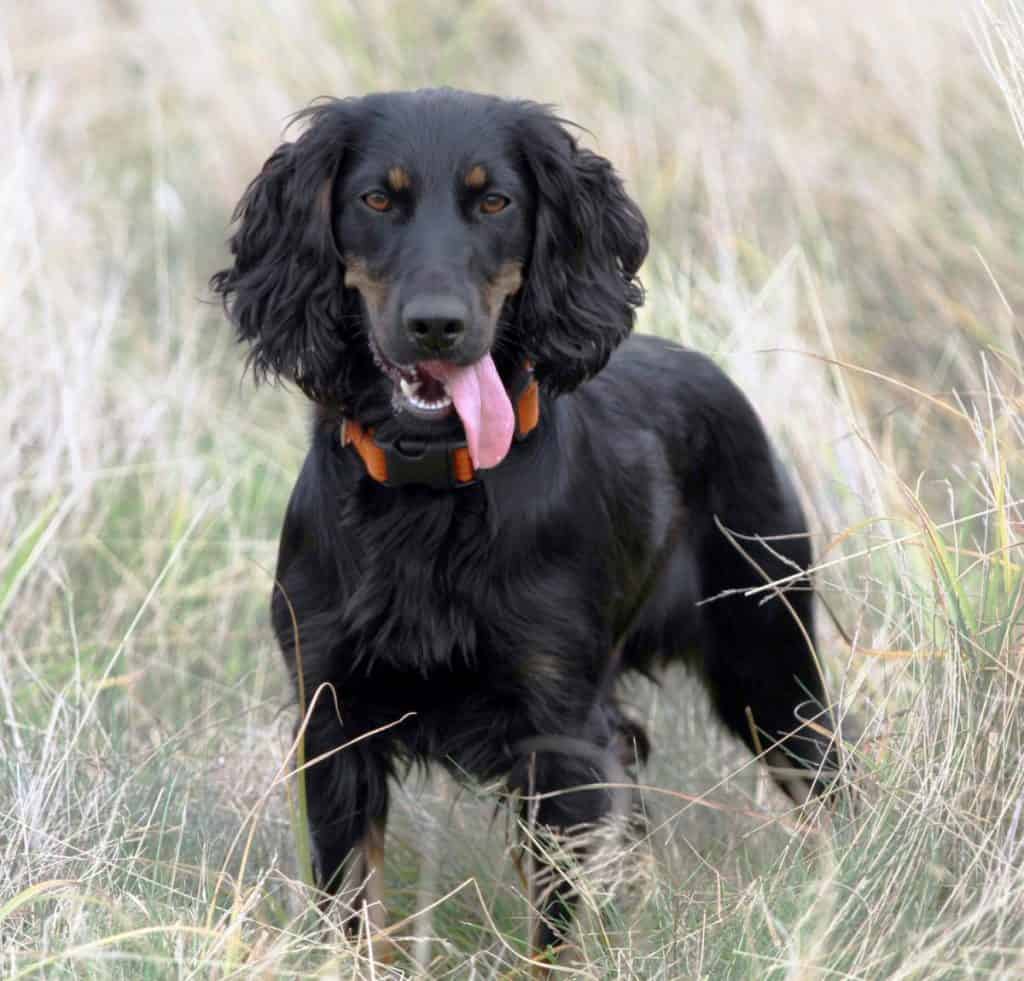
Distance Learning: To gain and improve a dog’s confidence and reduce the level of anxiety and timidity you need to use a consistent, gentle, positive, and measured approach.
If you try to speed up the process beyond the capability of the dog, then you will go backwards and your dog’s newfound confidence will plummet.
Firstly you must work out the distance where your dog feels fearful of a given situation, let’s say it is another dog, then you need to approach the dog with yours on a lead.
Never tighten the lead as this will convey your own anxiety to your dog. Watch your dog’s body language as soon as you see any submissive, aggressive or fearful reaction then stop and back up until the dog is relaxed again.
Once you have found the distance that allows the dog to relax then either treat or play with your dog using a favoured toy.
What we are looking for is a positive association whereby the dog sees the feared object which could be anything from a vacuum cleaner to a bus. As a matter of interest, dogs will not take food when they are fearful or stressed. This is instinctual as the flight mode kicks in, your dog does not want a full stomach when it may need to run away. This can also be used as an indicator of the dog’s state of mind even if there are no outward signs of distress.
Move in stages a little closer to whatever is causing the aggression or fear keep talking and reassuring the dog, you should be aiming to stay at a distance that allows the dog to feel reasonably relaxed. Gradually, over what could be many sessions you should reach the point where the dog will be comfortable, even though he is near to the object that caused the initial fear/reaction. Irrespective of whether it is another dog, place, or object gradual desensitisation should work for all.
Tools That Can Help: In cases where dogs are reactive to either people or dogs then simple noise aversion can help. You can teach the dog to turn its head away on a simple command like “OFF” In the many thousands of cases I have dealt with where reactivity or aggression was seen then I used (9) The Jingler and the OFF command plus it helps lead work like pulling and lunging it helps the dog break eye contact.
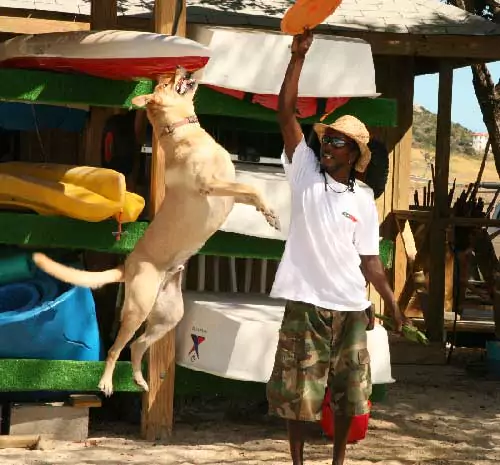
Play or Training Therapy: There is an exception to this if the dog has been recently frightened say by fireworks, you can actually act very blase and go immediately outside and play with toys such as balls or Frisbees, even a training session.
Praising for actions other than fear can really help. This can be done whilst the noise is going on.
You may, therefore, overcome a potential problem immediately.
Why this works is the same principle as for instance flying, the plane suddenly hits a lot of turbulence, watch everyone’s first reactions, they look to the Stewards or Stewardesses to see if they are showing anxiety or fear.
If they are calm and acting perfectly normally then our anxiety and fear will also start to dissipate.
It is worth trying this tactic when your dog has any negative experience, even though it does not appear too affected, just in case of a potential phobia later on.
Fireworks: Sound Aversion: Some dogs may become very distressed and fearful when they hear loud noises such as thunder, fireworks, gunshots or traffic sounds, This can cause some dogs to become extremely anxious and terrified this can lead to other aversion type behaviours.
Common reactions include hiding, shaking, panting, vomiting, defecation, urination, panic and occasionally destructive behaviours such as chewing through doors and walls to escape to safe territory. Hard as it may seem, you must not comfort your frightened dog, it will only encourage and reinforce their fears.
Sympathy and comfort to a dog are almost the opposite of how a human perceives it, Dogs see it as reinforcement rather than reassurance. Therefore you reinforce the anxiety and make the dog or puppy more concerned about the fear they are feeling. Be blasé, try and distract by playing a favourite game so he learns to cope on his own.
If you give him too much fuss he’ll think this means that there really is something to be scared about! If your dog is sound aversive then read my article (2) Fireworks and Sound Aversive Dogs a Treatment.
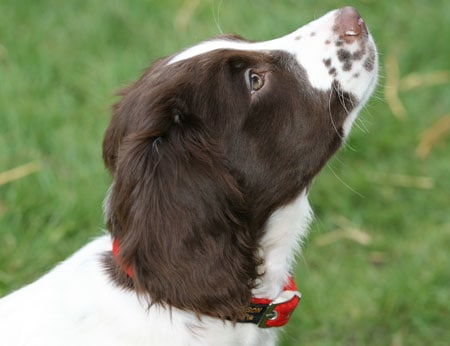
Focused Attention: One way of getting your dog to overcome certain fear situations is to gain the dog’s attention with treats, toys or your voice as you walk past whatever is causing the problem. This has a similar effect to using distance learning because the dog is thinking about something else instead. Therefore the intensity of the fear is reduced.
You will need treats or toys and any other interrupter for this method to work. I recommend either air-dried Sprats or Cheese, do not use treats to lure dogs. I always keep them out of sight until required. Sit next to the dog and call its name, it is even better if you can get a partner or friend to help on the other side.
Sit the dog between you and your partner or friend and say the dog’s name. If he doesn’t look at you, give his ear a gentle touch to gain his attention so that he turns his head towards you, As soon as this happens praise and treat enthusiastically, or play or use a toy. I always start with treats if possible. get your partner or a friend to be in front of or behind the dog to do the same, and keep repeating back and forth for a few minutes.
Do this regularly each day for at least a week and for the rest of the dog’s life occasionally, and he/she will always respond enthusiastically whenever its name is mentioned. It will also look at you. Never use the dog’s name in a negative situation, ie do not scold or punish using his/her name. Once you have got the dog to acknowledge his name then start these exercises:
To start focused attention say the dogs name and move away from the dog when he moves towards you immediately PRAISE and TREAT/PLAY I use the target word “good” in these circumstances. Remember do not show the treat until you are ready to give it or it will become part of the command.
When you give the treat try and align it between both yours and the dog’s eyes this will make sure you are making good eye contact. After a while you will see the dog making eye contact regularly, you can treat this action at this time so as to embed it.
Do these sequences at least 4 times in a row, ie name/move/praise/treat. The repetition is what teaches the dog to maintain that attention until you give the release command. The release command can be OK or whatever you choose to use. Practice this everywhere you go including training classes.
What you are looking for by performing these exercises is to tune out outside influences including the ones that are causing fear or aggressive responses. Once you can comfortably perform this exercise then use it to move gradually ever closer to the problem you are trying to overcome.
Over time you can momentarily release the dog’s attention increase this as you would using the distancing technique, if you get a fear response then you have moved too far too fast. And you must go back to where the dog last felt comfortable.

Neutering: Spaying and castration can have a major impact on our dogs, especially if it is done before the dogs have matured.
It is a fallacy that neutering cures aggression. The reality is that the vast majority of cases I deal with where it is either aggression against humans or inter-dog aggression is normally related to fear not dominance or guarding.
Neutering a fearful dog will definitely make the aggression increase not decrease.
Ir will also in almost every case make the dog more nervous and anxious.
So please do not listen to well-meaning friends who think they know best and certainly do not follow your Vets advice that neutering will help. There are some Vets that do understand that neutering will make matters worse and others that just look at the money they can make by recommending spay or castration knowing it w could intensify the condition.
Read my article on (3) Overview the Dangers of Neutering and think long and hard before spaying and castration, especially if the dog has not reached maturity. there is not one dog that reaches maturity by the time it is six months of age, a miniature Yorkshire Terrier one of the smallest dogs in the world, does not mature until ten months of age, an Irish Wolfhound is 36 months. Never consider neutering a fearful dog.
Punishment is not an Option:
It is of no use whatsoever punishing the dog for its fearful actions, this only causes more stress and therefore more fearful behaviour, therefore in the case of inter-dog aggression even more defensive behaviour. The dog had only three choices when confronted with a fearful situation these are commonly listed as the three Fs. Freeze, Flight or Fight. If the first two are found not to work the third one kicks in.
Let’s take the vacuum cleaner as an example. If you had watched your pup from the first time it was confronted by this “demon of the dark abyss” he would more than likely have crouched down as low as possible his body rigid, if the noise and the monster continued the puppy would have run away, probably under a table or a chair and if it came closer it would have growled and snarled probably making darting and biting motions especially when you playfully pushed the Hoover closer to see the pup’s reaction. Does anything ring a bell?
Some pups will be SO traumatised by the noise and the movement of the cleaner that they go into total freeze mode, our initial instinct would be to pick up and cuddle and comfort the frightened puppy. Perfectly natural human behaviour, something is frightened then nurture it.
Unfortunately, to a dog’s mind, this indicates that it is being praised for the fear, confirming his need to be fearful. If this happens when the puppy is between 8 to 10.5 weeks old, which is the first of several fear periods throughout the dog’s life, then that fear could be so deep-rooted as to be almost impossible to eradicate completely.
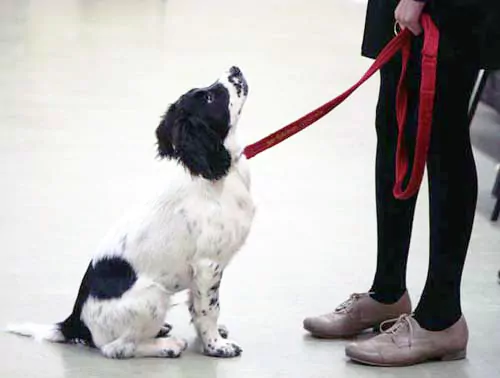
Obedience Classes?: Some dogs that are fearful or timid may benefit from a training class especially ones that are experienced in working with fear and aggression.
In the case of a rescue dog or an adult dog that you have re-homed. I would wait at least six weeks before embarking on this method.
Some very fearful dogs may be too nervous for classes until you’ve done some remedial work first.
A private trainer or better still a behaviourist should be able to help structure a positive approach, to help build up confidence in your dog, and also help determine when the dog is capable of classwork.
Do not make your dog jump into the deep end at classes or you can undo all the good work so far. Initially, keep the dog on the outer edge of the class and at a distance from anything the dog fears.
If you’ve developed focused attention before starting class, then this will be extremely useful for helping the dog relax in these situations. Some dogs may need several visits starting with very short periods at a time before actually participating in the classes.
Unfortunately, there will be dogs that will never be able to function well enough for this type of remedial work. If the dog has any tendency to snap at dogs or people or to bark inappropriately or lunge, then the Jingler can be an excellent training aid, that helps to eliminate this habit without introducing new problems.
Use your focused attention exercise to keep the dog’s mind off the person or dog he is reacting against. Be sure to remove the Jingler except when you are actively working the dog.
Could Other Treatments Help?: Change the diet: good quality food helps in many cases, most cheap food has cereal as filler, which can lead to a lack of serotonin, and low serotonin has been linked to aggression and anxiety. Many of the most common supermarket brands of dog food like Bakers and Pedigree have poor quality ingredients that can cause behavioural problems.
Read my articles on (4) Food and Behaviour and (5) Bakers and Pedigree. It will open your eyes to ingredients that go into the UK’s two most popular dog foods A nervous dog who eats a food overly high in poor-quality protein or sugar can experience even higher levels of anxiety.
I have written an article on dog food at the supposed high end of the quality food. (6) Royal Canin, Hills Science Plan and Burns Pet Food get a particularly bad review.
Therefore consider switching to a food with quality protein, it is not the level of protein that is the problem it is normally the quality of that protein. To check on the quality and level of protein of your dog’s food, look on the back or side of the dog food bag or can, where the percentage of protein will be listed. Levels usually vary from 14% (for aged dogs) all the way up to 25% (for puppies and working dogs).
I feed my dogs (7) Fish4Dogs Dry (Kibble). plus (8) Bella and Duke Raw food. Doing so may help calm down the nervous and fearful dog. There are no additives that can affect behaviour. If done in conjunction with regular exercise and a desensitisation program this can really help. I am generally against mainstream drugs that were created for humans, other than the following that can be used in situations of stress, fear, separation anxiety aggression, barking, and noise aversion etc, the one I tend to recommend is:
Unfortunately, you can feed the best food available and then ruin that by using treats with all the additives and fillers you are trying to avoid. That includes supposed teeth cleaning aids like Dentastix and Kongs. Dentastix are a real shocker and the ingredients are unbelievable, the kongs are rubber with pretty lurid colours nothing natural about them. (10) Why Some Dog Treats Can Be Dangerous. Your dogs should not be chewing on artificial aids they should be chewing on all-natural dog treats as nature intended..
To this end, I have created my own brand of Treats Free-range animals. Human grade livestock. Allowed to mature naturally, with no growth hormones, steroids or antibiotics. Fresh from pasture to driers to my shelves. Not stored in warehouses for months and sometimes years. Meat must also be guaranteed non-halal (11)Totally Natural Air Dried Dog Treats.

(12) Skullcap and Valerian: Is a traditional herbal remedy for the symptomatic relief of anxiety, nervousness, excitability and travel sickness,
It is also used as an adjunct in the treatment of epilepsy in dogs and cats.
Normally supplied in a sugar-coated tablet.
it helps to calm and relax dogs and cats suffering from, apprehension, phobias, hyperactivity, and anxiety sound aversions and many fear-related reactions.
It does not drug or cause drowsiness and comes from natural herbs.
I am afraid I have never seen any major improvements using any DAP diffuser products such as Adaptil.
I am also trialling a lactose-based anti-anxiety called Zylkene and will report on my findings shortly.
With all the above it is always prudent to discuss any medication herbal or otherwise with your Vet before embarking on any treatment program
if you found this article interesting please sign up for my Newsletters and get all my latest articles, information and comments.
Newsletter Sign Up
Stan Rawlinson. 2006
Updated regularly the last update was November 2020
(1) Breeders
(2) Fireworks and Sound Aversive Dogs a Treatment.
(3) Neutering
(6) Royal Canin, Hills Science Plan and Burns Pet Food
(7) Fish4Dogs
(8) Bella and Duke
(9) The Jingler
(10) Why Some Dog Treats Can Be Dangerous
(11) Totally Natural Air Dried Dog Treats
(12) Skullcap and Valerianhttps://www.doglistener.co.uk/dog-food-review-royal-canin-hills-and-burns
Understanding the fearful, nervous, anxious, timid and scared dog. including aggression related to fear.. Anxiety in dogs
The Fearful Anxious Nervous and Timid Dog
Fearful and anxious dogs are one of the commonest behavioural problems in domestic dogs. Some cases are genetic, however, most are created by the very people who really wanted the best for their dogs. It is often the breeders and the first owners that create this debilitating problem. This article will hopefully give you an insight into your own dog’s behaviour, and what you can do to help your dogs. and to understand what may have gone wrong so you can make sure you do not make the same mistakes again.

Socialisation is Vital: Socialisation is so vitally important that it almost outweighs all other considerations.
Lack of early socialisation is the most important and the commonest contributing factor in creating fearful, anxious and timid dogs
The fear of infections has led breeders and owners alike to make the tragic mistake of keeping their puppies isolated until they have completed their vaccinations.
Your dogs can mix with people and other vaccinated dogs from the day they are born.
The two most important time frames are 0-12 weeks Human Socialisation Period and 0-16 weeks Canine Socialisation Period.
Your puppy should have been handled by a minimum of 100 people by the time it is 12 weeks old. This should include children, adults and pensioners.
Over 90% of all cases of aggression against humans or other dogs are fear-based, yet we are constantly told that these aggressions are dominance-based That could not be further from the truth.
The breeder should play a vital part in this by inviting people to handle their puppies at a very young age. The canine socialisation period up to 16 weeks means they should be mixed with other dogs but more importantly other puppies. Pups learn communication skills, bite inhibition and body language from the boisterous play with other young puppies. Older dogs do not play as puppies do, therefore puppy classes that allow the pups to play together are absolutely crucial to your pups future confidence and mental health,
In my local area, there are lots of trainers and behaviourists that hold puppy classes. Quite a few do not have a clue about how puppies learn and do not even allow the puppies to play off the lead. If you are in one of these classes just walk out and demand your money back, if they do not allow this interaction between the other puppies. Why do they imagine they called Puppy Socialisation Classes.
By taking this stance they risk their clients ending up with a fearful, timid dog that may become aggressive in later life, (FACT “95% of all reported dog bites are fear related” Owners should try and strike a common-sense balance.
The First Weeks are Critical: Puppies, especially from birth through to 16 weeks must be exposed to a variety of experiences including people, places, and meeting other vaccinated dogs (this is perfectly safe). There are many activities and places to take dogs, without endangering their health or their lives, it is vital that you take the time to expose your new pup to as many of these situations as possible.
This is especially true for one’s second or third dog; it is too easy to keep the new pup in the company of the older dogs, depriving him of the opportunity to develop self-confidence of his own, without relying totally on the older dog/s and their protection. There is a vaccination that has been available for years, where the full course can be administered by ten and a half weeks rather than the normal twelve, therefore allowing two extra vital weeks of socialisation.
The vaccine is made by Intervet and is called Nobivac D.H.P.P.I/L. I would discuss this with your Vet if they don’t supply it ask why?

Genetics: Genetics, as well as socialisation. ie Nature and Nurture has a major impact on your dog’s ability to cope successfully with life.
Some are so solid genetically that whatever life throws at them they just bounce back.
I had a little rescue Jack Russell/Dachshund cross (A stretch limo Jack) called Charlie.
His early experiences were so horrific, that he should have had every hang up in the book.
See picture left. The abuse and injuries suffered by this poor little dog include both his back legs being fractured and snapped out of their socket, Front shoulder plate broken.
He has plates and pins all over him. Each one of his ribs was systematically broken at least three times over a period of 5 months.
This abuse started when he was 8 weeks old. He also has many other injuries,.including a fractured skull, collapsed eye socket and teeth missing. At one point he had black eyes and blood coming out of almost every orifice. His head was swollen to almost twice the normal size. The picture of him shows him smiling and happy.
He was so traumatised he would defecate, urinate and vomit if people approached him. His brother did not make it. he sadly died of head injuries at the hands of the sadist who then turned his full attention onto Charlie. This dog had been treated and put back together on numerous occasions, and each time the family had claimed it was an accident.
It was fairly clear this was not the case, especially after taking an X-ray of his ribs. Yet it appears the Vet was prepared to put this poor little dog back together and hand him back for more torture. I was asked to look at his temperament after a brilliant senior veterinary nurse called Helen, managed to convince the owners to give the dog up, with a view to re-homing. She looked after him personally and nursed him back to health.
There were no prosecutions!. After meeting him and hearing his awful story I was asked if I could work with him to try and overcome his massive fear of people. It took me almost three months to really get him to start to trust people and he stayed with me for the rest of his life Unfortunately I had difficulty going on holiday as he would just stop eating. He made a total and full recovery, his confidence soared, once again he loved and trusted people, his tail a constant blur was a testament to his ability to cope with everything life has thrown at him.
So despite a traumatic start, (the abuse started at eight weeks of age) he managed to overcome this and became one of the nicest and most loving dogs I have ever owned. He even became a PAT dog and was the only dog that was allowed into “Shooting “Star” The children’s Hospice in Greater London. Postscript Charlie died of heart failure aged 13 years in 2014, he is still sorely missed, not just by me and my family but everyone that ever met him, especially this that knew his story.
Many thanks go to Helen who impressed me so much that I decided to help her in her quest for more knowledge and understanding of the behaviour of dogs. She shadowed me in my work. Helen is now a behaviourist and trainer in her own right.

Unfortunately, not all dogs are so genetically sound. Even with an ideal environment, early socialisation and the perfect owner.
This may not be enough to help these hereditary unstable dogs. Their genetic temperament can and will determine how much improvement in personality and social skills the dog can achieve.
It is about time that some breeders came to the realisation that temperament, not looks or conformity, should be the main reason for breeding. Not money or accolades!
I have written an article about the impact (1) Breeders have on our dogs. The dog pictured above is a young Staffie I assessed under the Dangerous Dogs Act 1991.
Her owner was apprehended by the police in the street. They wrestled the man to the ground and arrested him. She panicked so much she barked and threatened the police and then went to nip them.
She was six months old when taken into custody and put in solitary confinement for her actions for months on end. I assessed this poor dog for temperament and aggression. Because of that report and my appearance in court to defend her meant that she was fortunately returned to her owner.
However, her life and fears will probably be with her until she dies. Just sometimes our police and the law should take into consideration the age and circumstances of the dog when deciding to prosecute in cases like these..
Is There a Cure?: With fear behaviour, don’t expect a 100% cure. There is no miracle word or magic wand that miraculously changes the dog, do not underestimate the amount of work involved. Yes, you can create a less fearful and anxiety-ridden dog, but only to the level that the dog can sustain.
The type of owner or trainer that believes that the fearful dog should be thrust headlong into every situation, and that will desensitise and cure them is sadly disillusioned. The old trick of throwing a child into a swimming pool in the hope it would quickly learn to swim is now hopefully outdated.
It achieved nothing except possibly leaving the victim with a lifelong fear of water. Crashing headlong into circumstances the dog cannot cope with will normally produce similar results. You should also give careful consideration to whether you want, or indeed have the time, stamina and patience to treat and work with a dog that has fears and phobias?
If you do not possess the above traits, it may be better for both of you to separate, and the dog is rehomed with someone that is hopefully experienced with this type of problem, and who has the necessary temperament to deal with a dog that can at the best of times exasperating, and at the worst infuriating.

Distance Learning: To gain and improve a dog’s confidence and reduce the level of anxiety and timidity you need to use a consistent, gentle, positive, and measured approach.
If you try to speed up the process beyond the capability of the dog, then you will go backwards and your dog’s newfound confidence will plummet.
Firstly you must work out the distance where your dog feels fearful of a given situation, let’s say it is another dog, then you need to approach the dog with yours on a lead.
Never tighten the lead as this will convey your own anxiety to your dog. Watch your dog’s body language as soon as you see any submissive, aggressive or fearful reaction then stop and back up until the dog is relaxed again.
Once you have found the distance that allows the dog to relax then either treat or play with your dog using a favoured toy.
What we are looking for is a positive association whereby the dog sees the feared object which could be anything from a vacuum cleaner to a bus. As a matter of interest, dogs will not take food when they are fearful or stressed. This is instinctual as the flight mode kicks in, your dog does not want a full stomach when it may need to run away. This can also be used as an indicator of the dog’s state of mind even if there are no outward signs of distress.
Move in stages a little closer to whatever is causing the aggression or fear keep talking and reassuring the dog, you should be aiming to stay at a distance that allows the dog to feel reasonably relaxed. Gradually, over what could be many sessions you should reach the point where the dog will be comfortable, even though he is near to the object that caused the initial fear/reaction. Irrespective of whether it is another dog, place, or object gradual desensitisation should work for all.
Tools That Can Help: In cases where dogs are reactive to either people or dogs then simple noise aversion can help. You can teach the dog to turn its head away on a simple command like “OFF” In the many thousands of cases I have dealt with where reactivity or aggression was seen then I used (9) The Jingler and the OFF command plus it helps lead work like pulling and lunging it helps the dog break eye contact.

Play or Training Therapy: There is an exception to this if the dog has been recently frightened say by fireworks, you can actually act very blase and go immediately outside and play with toys such as balls or Frisbees, even a training session.
Praising for actions other than fear can really help. This can be done whilst the noise is going on.
You may, therefore, overcome a potential problem immediately.
Why this works is the same principle as for instance flying, the plane suddenly hits a lot of turbulence, watch everyone’s first reactions, they look to the Stewards or Stewardesses to see if they are showing anxiety or fear.
If they are calm and acting perfectly normally then our anxiety and fear will also start to dissipate.
It is worth trying this tactic when your dog has any negative experience, even though it does not appear too affected, just in case of a potential phobia later on.
Fireworks: Sound Aversion: Some dogs may become very distressed and fearful when they hear loud noises such as thunder, fireworks, gunshots or traffic sounds, This can cause some dogs to become extremely anxious and terrified which can lead to other aversion-type behaviours.
Common reactions include hiding, shaking, panting, vomiting, defecation, urination, panic and occasionally destructive behaviours such as chewing through doors and walls to escape to safe territory. Hard as it may seem, you must not comfort your frightened dog, it will only encourage and reinforce their fears.
Sympathy and comfort to a dog are almost the opposite of how a human perceives it, Dogs see it as reinforcement rather than reassurance. Therefore you reinforce the anxiety and make the dog or puppy more concerned about the fear they are feeling. Be blasé, try and distract by playing a favourite game so he learns to cope on his own.
If you give him too much fuss he’ll think this means that there really is something to be scared about! If your dog is sound aversive then read my article (2) Fireworks and Sound Aversive Dogs a Treatment.

Focused Attention: One way of getting your dog to overcome certain fear situations is to gain the dog’s attention with treats, toys or your voice as you walk past whatever is causing the problem. This has a similar effect to using distance learning because the dog is thinking about something else instead. Therefore the intensity of the fear is reduced.
You will need treats or toys and any other interrupter for this method to work. I recommend either air-dried Sprats or Cheese, do not use treats to lure dogs. I always keep them out of sight until required. Sit next to the dog and call its name, it is even better if you can get a partner or friend to help on the other side.
Sit the dog between you and your partner or friend and say the dog’s name. If he doesn’t look at you, give his ear a gentle touch to gain his attention so that he turns his head towards you, As soon as this happens praise and treat him enthusiastically, or play or use a toy. I always start with treats if possible. get your partner or a friend to be in front of or behind the dog to do the same, and keep repeating back and forth for a few minutes.
Do this regularly each day for at least a week and for the rest of the dog’s life occasionally, and he/she will always respond enthusiastically whenever its name is mentioned. It will also look at you. Never use the dog’s name in a negative situation, ie do not scold or punish using his/her name. Once you have got the dog to acknowledge his name then start these exercises:
To start focused attention say the dogs name and move away from the dog when he moves towards you immediately PRAISE and TREAT/PLAY I use the target word “good” in these circumstances. Remember do not show the treat until you are ready to give it or it will become part of the command.
When you give the treat try and align it between both your and the dog’s eyes this will make sure you are making good eye contact. After a while you will see the dog making eye contact regularly, you can treat this action at this time so as to embed it.
Do these sequences at least 4 times in a row, ie name/move/praise/treat. The repetition is what teaches the dog to maintain that attention until you give the release command. The release command can be OK or whatever you choose to use. Practice this everywhere you go including training classes.
What you are looking for by performing these exercises is to tune out outside influences including the ones that are causing fear or aggressive responses. Once you can comfortably perform this exercise then use it to move gradually ever closer to the problem you are trying to overcome.
Over time you can momentarily release the dog’s attention and increase this as you would using the distancing technique, if you get a fear response then you have moved too far too fast. And you must go back to where the dog last felt comfortable.

Neutering: Spaying and castration can have a major impact on our dogs, especially if it is done before the dogs have matured.
It is a fallacy that neutering cures aggression. The reality is that the vast majority of cases I deal with where it is either aggression against humans or inter-dog aggression is normally related to fear not dominance or guarding.
Neutering a fearful dog will definitely make the aggression increase not decrease.
Ir will also in almost every case make the dog more nervous and anxious.
So please do not listen to well-meaning friends who think they know best and certainly do not follow your Vets advice that neutering will help. There are some Vets that do understand that neutering will make matters worse and others that just look at the money they can make by recommending spay or castration knowing it w could intensify the condition.
Read my article on (3) Overview The Dangers of Neutering and think long and hard before spaying and castration, especially if the dog has not reached maturity. there is not one dog that reaches maturity by the time it is six months of age, a miniature Yorkshire Terrier one of the smallest dogs in the world, does not mature until ten months of age, an Irish Wolfhound is 36 months. Never consider neutering a fearful dog.
Punishment is not an Option:
It is of no use whatsoever punishing the dog for its fearful actions, this only causes more stress and therefore more fearful behaviour, therefore in the case of inter-dog aggression even more defensive behaviour. The dog had only three choices when confronted with a fearful situation these are commonly listed as the three Fs. Freeze, Flight or Fight. If the first two are found not to work the third one kicks in.
Let’s take the vacuum cleaner as an example. If you had watched your pup from the first time it was confronted by this “demon of the dark abyss” he would more than likely have crouched down as low as possible his body rigid, if the noise and the monster continued the puppy would have run away, probably under a table or a chair and if it came closer it would have growled and snarled probably making darting and biting motions especially when you playfully pushed the Hoover closer to see the pup’s reaction. Does anything ring a bell?
Some pups will be SO traumatised by the noise and the movement of the cleaner that they go into total freeze mode, our initial instinct would be to pick up and cuddle and comfort the frightened puppy. Perfectly natural human behaviour, if something is frightened then nurture it.
Unfortunately, to a dog’s mind, this indicates that it is being praised for the fear, confirming his need to be fearful. If this happens when the puppy is between 8 to 10.5 weeks old, which is the first of several fear periods throughout the dog’s life, then that fear could be so deep-rooted as to be almost impossible to eradicate completely.

Obedience Classes?: Some dogs that are fearful or timid may benefit from a training class especially ones that are experienced in working with fear and aggression.
In the case of a rescue dog or an adult dog that you have re-homed. I would wait at least six weeks before embarking on this method.
Some very fearful dogs may be too nervous for classes until you’ve done some remedial work first.
A private trainer or better still a behaviourist should be able to help structure a positive approach, to help build up confidence in your dog, and also help determine when the dog is capable of classwork.
Do not make your dog jump into the deep end at classes or you can undo all the good work so far. Initially, keep the dog on the outer edge of the class and at a distance from anything the dog fears.
If you’ve developed focused attention before starting class, then this will be extremely useful for helping the dog relax in these situations. Some dogs may need several visits starting with very short periods at a time before actually participating in the classes.
Unfortunately, there will be dogs that will never be able to function well enough for this type of remedial work. If the dog has any tendency to snap at dogs or people or to bark inappropriately or lunge, then the Jingler can be an excellent training aid, that helps to eliminate this habit without introducing new problems.
Use your focused attention exercise to keep the dog’s mind off the person or dog he is reacting against. Be sure to remove the Jingler except when you are actively working the dog.
Could Other Treatments Help?: Change the diet: good quality food helps in many cases, most cheap food has cereal as filler, which can lead to a lack of serotonin, and low serotonin has been linked to aggression and anxiety. Many of the most common supermarket brands of dog food like Bakers and Pedigree have poor quality ingredients that can cause behavioural problems.
Read my articles on (4) Food and Behaviour and (5) Bakers and Pedigree. It will open your eyes to ingredients that go into the UK’s two most popular dog foods A nervous dog who eats a food overly high in poor-quality protein or sugar can experience even higher levels of anxiety.
I have written an article on dog food at the supposed high end of the quality food. (6) Royal Canin, Hills Science Plan and Burns Pet Food get a particularly bad review.
Therefore consider switching to a food with quality protein, it is not the level of protein that is the problem it is normally the quality of that protein. To check on the quality and level of protein of your dog’s food, look on the back or side of the dog food bag or can, where the percentage of protein will be listed. Levels usually vary from 14% (for aged dogs) all the way up to 25% (for puppies and working dogs).
I feed my dogs (7) Fish4Dogs Dry (Kibble). plus (8) Bella and Duke Raw food. Doing so may help calm down the nervous and fearful dog. There are no additives that can affect behaviour. If done in conjunction with regular exercise and a desensitisation program this can really help. I am generally against mainstream drugs that were created for humans, other than the following that can be used in situations of stress, fear, separation anxiety aggression, barking, and noise aversion etc, the one I tend to recommend is:
Unfortunately, you can feed the best food available and then ruin that by using treats with all the additives and fillers you are trying to avoid. That includes supposed teeth cleaning aids like Dentastix and Kongs. Dentastix are a real shocker and the ingredients are unbelievable, the kongs are rubber with pretty lurid colours nothing natural about them. (10) Why Some Dog Treats Can Be Dangerous. Your dogs should not be chewing on artificial aids they should be chewing on all-natural dog treats as nature intended..
To this end, I have created my own brand of Treats Free-range animals. Human grade livestock. Allowed to mature naturally, with no growth hormones, steroids or antibiotics. Fresh from pasture to driers to my shelves. Not stored in warehouses for months and sometimes years. Meat must also be guaranteed non-halal (11)Totally Natural Air Dried Dog Treats.

(12) Skullcap and Valerian: Is a traditional herbal remedy for the symptomatic relief of anxiety, nervousness, excitability and travel sickness,
It is also used as an adjunct in the treatment of epilepsy in dogs and cats.
Normally supplied in a sugar-coated tablet.
it helps to calm and relax dogs and cats suffering from, apprehension, phobias, hyperactivity, and anxiety sound aversions and many fear-related reactions.
It does not drug or cause drowsiness and comes from natural herbs.
I am afraid I have never seen any major improvements using any DAP diffuser products such as Adaptil.
I am also trialling a lactose-based anti-anxiety called Zylkene and will report on my findings shortly.
With all the above it is always prudent to discuss any medication herbal or otherwise with your Vet before embarking on any treatment program
if you found this article interesting please sign up for my Newsletters and get all my latest articles, information and comments.
Newsletter Sign Up
Stan Rawlinson. 2006
Updated regularly the last update was November 2020
(1) Breeders
(2) Fireworks and Sound Aversive Dogs a Treatment.
(3) Neutering
(6) Royal Canin, Hills Science Plan and Burns Pet Food
(7) Fish4Dogs
(8) Bella and Duke
(9) The Jingler
(10) Why Some Dog Treats Can Be Dangerous



